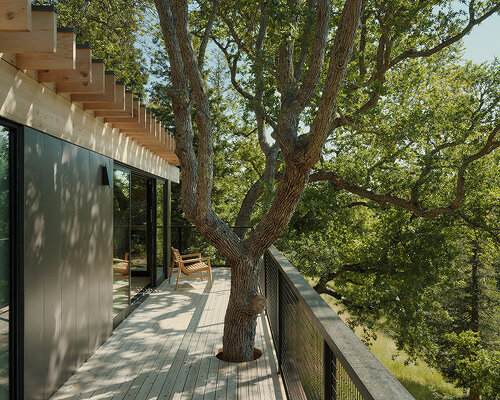immersive architecture amid California’s hillside canopy
Set on a steep hillside surrounded by mature redwoods and oaks, Pavilion in the Oaks by Mork-Ulnes Architects introduces a restrained counterpoint to the overgrown landscape. Designed as an extension to a 1970s suburban home, the project serves as both a wellness retreat and a space for social gathering, connected to the existing residence by a narrow bridge. The pavilion is raised above the sloping terrain, its floor level aligned with the home’s walk-out basement, allowing it to hover lightly among the trunks.
The clients envisioned a flexible environment for yoga, exercise, and family gatherings — a place where domestic life could shift fluidly between introspection and conviviality. Mork-Ulnes responded with a composition that prioritizes continuity between interior and exterior. The result is an architecture that feels inseparable from the surrounding grove, shaped by the vertical rhythm of the trees and the filtered light that moves through their branches.
images ©
pavilion in the oaks: an extension to an existing home
The team at Mork-Ulnes Architects elevates its Pavilion in the Oaks atop an array of slender columns, preserving the sloping site’s natural contours and allowing air and light to circulate beneath. Redwood and oak trees puncture the exterior deck, defining zones of use as naturally as walls or furniture might. This interplay between architecture and vegetation gives the project a sense of suspension — part clearing, part enclosure — where the built and the organic share coexist.
Positioned opposite the main house, the new volume completes a three-sided courtyard that has become the home’s primary summer gathering space. The gentle grade of the slope, the continuity of decking between the buildings, and the density of the canopy together create an atmosphere of privacy and calm, even in moments of activity.
Mork-Ulnes Architects’ Pavilion in the Oaks is suspended among the trees on a steep California hillside
the timber structure by mork-ulnes architects
Inside, Mork-Ulnes organizes the Pavilion in the Oaks around a compact cedar-clad core containing the bathroom and sauna. The remainder of the floor plan remains open and adaptable, accommodating movement and gatherings with equal ease. Operable sliding doors encircle the space and allow the perimeter to open entirely to the landscape.
The roof structure continues this sense of exposure and shelter. Exposed cedar framing supports nine skylights that scatter daylight across the interior, producing a soft dappled pattern reminiscent of the canopy above. Light moves across the timber ceiling in shifting tones through the day. This way, the project maintains a sensory link to the hillside environment even when the pavilion is closed.
the pavilion connects to an existing 1970s home by a bridge, extending the living space into the landscape
slender columns lift the structure above the ground to preserve the natural slope and canopy
the pavilion completes a three-sided courtyard that serves as the home’s main summer space
nine skylights bring filtered daylight through exposed cedar framing
a cedar-clad core contains the sauna and bathroom at the heart of the plan
redwood and oak trees grow through the deck, anchoring the architecture to its site
project info:
name: Pavilion in the Oaks
architects: Mork-Ulnes Architects | @morkulnesarchitects
location: Monte Sereno, California, USA
design team: Casper MorkUlnes, Robert Scott, Alex Still
built area: 650 square feet (conditioned), 1,584 square feet (deck)
completion: Spring 2025
photography: © Joe Fletcher | @joefletcherphoto
builder: Hummel Custom Construction
structural engineer: Daedalus
civil engineer: Lea & Braze Engineering
arborist: Urban Tree Management
geotechnical engineer: Romig Engineers
energy analyst: Monterey Energy Group
The post mork-ulnes extends california home with pavilion punctuated by oak and redwood trees appeared first on designboom | architecture & design magazine.

